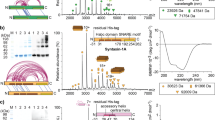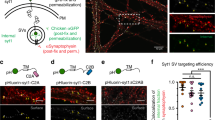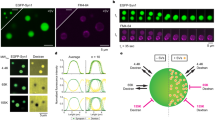Abstract
Synaptic vesicle docking and fusion are mediated by the assembly of a stable SNARE core complex of proteins, which include the synaptic vesicle membrane protein VAMP/synaptobrevin and the plasmalemmal proteins syntaxin and SNAP–25. We have now identified another SNAP–25–binding protein, called Snapin. Snapin was enriched in neurons and exclusively located on synaptic vesicle membranes. It associated with the SNARE complex through direct interaction with SNAP–25. Binding of recombinant Snapin–CT to SNAP–25 blocked the association of the SNARE complex with synaptotagmin. Introduction of Snapin–CT and peptides containing the SNAP–25 binding sequence into presynaptic superior cervical ganglion neurons in culture reversibly inhibited synaptic transmission. These results suggest that Snapin is an important component of the neurotransmitter release process through its modulation of the sequential interactions between the SNAREs and synaptotagmin.
This is a preview of subscription content, access via your institution
Access options
Subscribe to this journal
Receive 12 print issues and online access
$209.00 per year
only $17.42 per issue
Buy this article
- Purchase on Springer Link
- Instant access to full article PDF
Prices may be subject to local taxes which are calculated during checkout






Similar content being viewed by others
References
Rothman, J. E. Mechanisms of intracellular protein transport. Nature 372, 55–63 (1994).
Bajjalieh, S. M. & Scheller, R. H. The biochemistry of neurotransmitter secretion. J. Biol. Chem. 270, 1971–1974 (1995).
Südhof, T. C. The synaptic vesicle cycle: a cascade of protein–protein interactions. Nature 375, 645–653 (1995).
Trimble, W. S., Cowan, D. M. & Scheller, R. H. VAMP–1: a synaptic vesicle–associated integral membrane protein. Proc. Natl. Acad. Sci. USA 85, 4538–4542 (1988).
Bennett, M. K., Calakos, N. & Scheller, R. H. Syntaxin: a synaptic protein implicated in docking of synaptic vesicles at presynaptic active zones. Science 257, 255–259 (1992).
Yoshida, A. et al. HPC–1 is associated with synaptotagmin and ω–conotoxin receptor. J. Biol. Chem. 267, 24925– 24928 (1992).
Oyler, G. A. et al The identification of a novel synaptosomal–associated protein, SNAP–25, differentially expressed by neuronal subpopulations. J. Cell. Biol. 109, 3039– 3052 (1989).
Söllner, T. et al. SNAP receptors implicated in vesicle targeting and fusion. Nature 362, 318–324 (1993).
Calakos, N., Bennett, M. K., Peterson, K. & Scheller, R. H. Protein–protein interactions contributing to the specificity of intracellular vesicular trafficking. Science 263, 1146 –1149 (1994).
Hayashi, T. et al Synaptic vesicle membrane fusion complex: action of clostridial neurotoxins on assembly. EMBO J. 13, 5051 –5061 (1994).
Fields, F. & Song, O. A novel genetic system to detect protein–protein interactions. Nature 340, 245– 246 (1989).
Bean, A. J., Seifert, R., Chen, Y. A., Sacks, R. & Scheller, R. H. Hrs–2 is an ATPase implicated in calcium–regulated secretion. Nature 385, 826– 829 (1997).
Kozak, M. An analysis of 5'–noncoding sequences from 699 vertebrate messenger RNAs. Nucleic Acids Res. 15, 8125– 8131 (1987).
Weimbs, T. et al. A conserved domain is present in different families of vesicular fusion proteins: A new superfamily. Proc. Natl. Acad. Sci. USA 94, 3046–3051 ( 1997).
Ravichandran, V., Chawla, A. & Roche, P. A. Identification of a novel syntaxin– and synaptobrevin/VAMP–binding protein, SNAP–23, expressed in non–neuronal tissues. J. Biol. Chem. 271, 13300–13303 (1996).
Matthew. W. D., Tsavaler, L. & Reichardt, L. F. Identification of a synaptic vesicle–specific membrane protein with a wide distribution in neuronal and neurosecretory tissue. J. Cell. Biol. 91, 257– 269 (1981).
Mochida, S. et al. Myosin II is involved in transmitter release at synapses formed between rat sympathetic neurons in culture. Neuron 13, 1131–1142 (1994).
Mochida, S., Saisu, H., Kobayashi, H. & Abe, T. Impairment of syntaxin by botulinum neurotoxin C1 or antibodies inhibits acetylcholine release but not Ca2+ channel activity. Neuroscience 65, 905–915 (1995).
Mochida, S., Sheng, Z.–H., Baker, C., Kobayashi, H. & Catterall, W. A. Inhibition of neurotransmission by peptides containing the synaptic protein interaction site of N–type Ca2+ channels. Neuron 17, 781–788 (1996).
Li, C. et al. Ca2+–dependent and –independent activities of neural and nonneural synaptotagmins. Nature 375, 594–599 (1995).
Bommert, K. et al. Inhibition of neurotransmitter release by C2–domain peptides implicates synaptotagmin in exocytosis. Nature 363, 163–165 (1993).
Pusch, M. & Neher, E. Rates of diffusional exchange between small cells and a measuring patch pipette. Pflügers Arch. 411, 204–211 ( 1988).
Cornille, F., Deloye, F., Fournié–Zaluski, M.–C., Roques, B. P. & Poulain, B. Inhibition of neurotransmitter release by synthetic proline–rich peptides shows that the N–terminal domain of vesicle–associated membrane protein/synaptobrevin is critical for neuroexocytosis. J. Biol. Chem. 270, 16826–16832 ( 1995).
Doussau, F., Clabecq, A., Henry, J.–P., Darchen, F. & Poulain, B. Calcium–dependent regulation of rab 3 in short–term plasticity. J. Neurosci. 18, 3147–3157 (1998).
Wakshull, E., Johnson, M. I. & Burton, H., Postnatal rat sympathetic neurons in culture. I. A comparison with embryonic neurons. J. Neurophysiol. 42, 1410–1425 (1979).
Broadie, K. et al. Syntaxin and synaptobrevin function downstream of vesicle docking in Drosophila. Neuron 15, 663– 673 (1995).
Hunt, J. M. et al. A post–docking role for synaptobrevin in synaptic vesicle fusion. Neuron 12, 1269– 1279 (1994).
Sweeney, S. T., Broadie, K., Keane, J., Niemann, H. & O'Kane, C. J. Targeted expression of tetanus toxin light chain in Drosophila specifically eliminates synaptic transmission and causes behavioral defects. Neuron 14, 341– 351 (1995).
Sheng, Z.–H., Rettig, J., Cook, T. & Catterall, W. A. Calcium–dependent interaction of N–type calcium channels with the synaptic core complex. Nature 379, 451–454 (1996).
Dunkley, P. R. et al. A rapid percoll gradient procedure for isolation of synaptosomes directly from an S1 fraction: homogeneity and morphology of subcellular fractions. Brain Res. 441, 59–71 (1988).
Hillier, L. et al., Generation and analysis of 280,000 human expressed sequence tags. Genome Res. 6, 807– 828 (1996).
Acknowledgements
We thank Q. Lao for help with the yeast two–hybrid system, X. Zheng for help with synaptosome fractionation, M Takahashi for antibodies, P.A. Roche for SNAP–23 cDNA and S. C. Landis, H. Gainer, R. D. G. McKay, M. Mayer, H. Arnheiter and J. Rettig for comments on the manuscript. This work was supported by the intramural research program of NINDS, NIH (J.M.I and Z.–H.S.), HHMI–NIH Research Scholars Program (J.M.I.), grants from The Japanese Ministry of Education, Science and Culture (S.M.) and the Human Frontier Science Program (S.M.).
Author information
Authors and Affiliations
Corresponding author
Rights and permissions
About this article
Cite this article
Ilardi, J., Mochida, S. & Sheng, ZH. Snapin: a SNARE–associated protein implicated in synaptic transmission . Nat Neurosci 2, 119–124 (1999). https://doi.org/10.1038/5673
Received:
Accepted:
Issue Date:
DOI: https://doi.org/10.1038/5673
This article is cited by
-
Changes in cognitive function, synaptic structure and protein expression after long-term exposure to 2.856 and 9.375 GHz microwaves
Cell Communication and Signaling (2023)
-
DYRK3 phosphorylates SNAPIN to regulate axonal retrograde transport and neurotransmitter release
Cell Death Discovery (2022)
-
NG2 glia-derived GABA release tunes inhibitory synapses and contributes to stress-induced anxiety
Nature Communications (2021)
-
The Rab5 activator RME-6 is required for amyloid precursor protein endocytosis depending on the YTSI motif
Cellular and Molecular Life Sciences (2020)
-
Structural and Functional Characterization of the Interaction of Snapin with the Dopamine Transporter: Differential Modulation of Psychostimulant Actions
Neuropsychopharmacology (2018)



